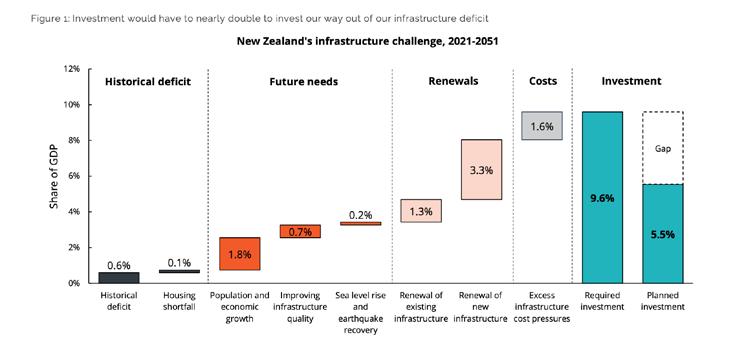
11 minute read
Sweating the assets: Market efficiency and infrastructure development
John Walton
[Adam Smith]
As I write this article, the country is reeling from the havoc caused by Cyclone Gabrielle. Much of the North, Tairāwhiti and Hawke’s Bay is under water, people are unaccounted for, bridges are down, roads washed out, electricity and water infrastructure heavily damaged, and telecommunications down. The death toll continues to climb as rescue services push into isolated communities.
One word which we are hearing a lot is “unprecedented”; the Christchurch earthquake; the Kaikoura earthquake which followed; the Covid pandemic; the flooding in Auckland in January; and cyclone Gabrielle; each “unprecedented”. And while each event has shown the “resilience” of our communities, bringing us together in adversity, they also show how fragile our essential infrastructure has become.
A report prepared for Te Waihanga – Infrastructure Commission in October 2021 identified $104 billion more capital investment required to meet the shortfall in 2021.2
If that target was not met, then an additional $106 billion would be required by 2051. At that time, planned infrastructure investment was $4.1 billion less than the investment required to meet the 2021 shortfall (see chart below).
While these numbers are hard to digest, we should not be discouraged by the size of the task. The solution is, first, long term planning of essential infrastructure investment; second, cross-party political commitment to meet that cost; third, procurement through the effective, rather than ideological, combined use of the public and private sectors; and last, regulatory intervention in markets.
What is often overlooked in this discussion is that the public pays for infrastructure provision, whether in taxes and rates or in user charges. The goal must be meeting our infrastructure needs cost effectively.
Essential infrastructure
While Adam Smith’s butcher may strive, not out of benevolence but out of self-interest, there are significant and legitimate aspects of our lives for which we expect Government support, beyond self-interest. We expect, not unreasonably, potable water to flow from our taps; reliable electricity to heat our homes; reliable telecommunications; safe streets; responsive health services; and world class education for our children.
Historically, each was provided by government, whether central or municipal – planned, developed and maintained by technical experts in each field, and paid for by the public through taxes and rates.

With the growth of monetarism, propounded by Milton Friedman of the Chicago School of Economics and enthusiastically adopted by Ronald Reagan and Margaret Thatcher in the 1980s, successive governments, including our own, moved away from the prevailing Keynesian focus on state investment in infrastructure. Investment decisions were made, not on the advice of technical experts and planners, but on the policy recommendations of economists and management consultants, and increasingly with shareholder dividends front of mind.
While there is no doubt that significant structural reform was desperately needed, particularly in the years culminating in the disastrous Muldoon government, much like taking aspirin, one or two tablets might ease the pain; taking the whole bottle, not so much!
What has been missing is a long term infrastructure plan and a commitment to implement it; however “unsexy” those projects may be.
“Sweating the Asset”
Privatisation and corporatisation of much of our essential infrastructure since those reforms has included requirements, whether in statutes or statements of corporate intent, to operate as “successful businesses”. “Sweating the assets” has become the mantra; and market efficiency, both in the management of infrastructure and its funding, the driving force.
At its simplest, sweating the assets refers to working assets harder; by increasing efficiency in operating costs and delaying new capital investment as long as possible; and by re-using, repurposing or re-assigning assets which would have been disposed of in the past as soon as they are depreciated.
This focus on efficiency may be applauded, provided it is coupled with realistic planning for future demand and acceptable provision for redundancy for disruptive, and increasingly catastrophic, events.
Taking Cyclone Gabrielle as a case in point, extreme weather events are hardly unexpected. Climate change, and specifically global warming, is not new. Swedish scientist Svante Arrhenius posited that burning fossil fuels would add carbon dioxide to the atmosphere resulting in a “greenhouse effect” (anthropogenic climate change) in an essay in 1896. “Global warming” came into the public domain in a paper by Wallace Broecker published in the magazine Science in 1975.
While the specifics of Cyclone Gabrielle may not have been known until the few days before the cyclone hit, like the covid pandemic, it may have been “unprecedented”, but it was not unexpected. What the cyclone has revealed is a failure of planning and the lack of redundancy in our essential infrastructure.
Sweating the assets has deferred investment in critical infrastructure, increasing the risk and consequences of failure in adverse events.
Market efficiency
Central to the ideological belief in small government, proponents of the Chicago School of Economics hold to the view that the private sector has better access to capital markets, and is more efficient in service delivery.
There can be no argument that the private sector can be more agile and more innovative than governments tend to be. However, these benefits come with the primary focus on profit, through cost reduction and price maximisation, without regard to wider social priorities. As Adam Smith observed in the opening quote, markets are driven by self-interest. Competition, that great driver of innovation, ultimately results in a race to the bottom.
Governments, both central and local, are similarly driven by the self-interest of decision-makers to ensure reelection and legacy; vanity projects displacing less glamorous investment in pipes in the ground and ensuring stormwater separation from the wastewater network.
The ideal has to be neither one nor the other, but a nuanced mix of the benefits of the two.
The two primary drivers for private investment in infrastructure are access to capital markets (taking the cost of infrastructure development off-balance sheet for governments) and operational efficiency.
On the first, governments enjoy sovereign risk giving them the cheapest access to capital. The only benefits in private sector funding are to take capital investment offbalance sheet for the government, converting the capital cost of infrastructure development into operational cost, and overcoming legislative constraints on borrowing. Whichever approach is adopted, the public, whether through taxes, rates or user charges, pays for the development.
The biggest difference between the two funding models is that the government can borrow more cheaply than the private sector, and the private sector will always include an allowance for profit in its modelling.
On the second benefit, operational efficiency, there is frequently a misalignment of priorities, with the private sector driven by immediate gain and government seeking to ensure maintaining long-term stability, with provision for redundancy.
The solution must surely be a mix of the two. Given the appropriate regulatory environment, there is no reason a government entity cannot meet operational requirements, with private sector input, while maintaining the public interest in social and environmental issues, long term planning and investment.
The alternative?
There is no one size fits all. Each sector will require a different approach to deal with a history of underinvestment and a lack of targeted planning.
The issues with water are not limited to dealing with under investment in three waters. Industrial and agricultural use of water has historically been without regard to its impact on our waterways. We are now in the position where, rather than dealing with the issue, the problem has become politicised.
Electricity is in desperate need of structural reform, with spot market pricing being fixed by the last generator to export onto the market, rewarding all generators with the highest, most recent market price rather than the cost of generation. Similarly, the market does not prioritise or reward renewable generation over thermal or other less environmentally friendly modes of generation.
At current projections, the Government will be forced to proceed with the Onslow pumped hydro scheme to meet demand. Part of that decision will have to include a reconsideration of the electricity spot market, and how generation is dispatched.
In terms of long-term planning, generators respond to immediate demand and profit maximisation. Granted, generators can move reasonably quickly with the development of wind, solar and thermal generation (hydro, not so much), but the national and local networks do not have such flexibility. Much like water, the electricity sector lacks any strategy to meet growing demand against environmental constraints. Burning more coal cannot be the answer.
Similarly, building more roads cannot be the solution to transportation under-investment. As mentioned in the Infrastructure Commission report referred to above, building more roads will simply result in the greater use of cars, trucks and buses.
Whichever industry sector is selected, the issue is the same – long term planning and properly targeted investment has been lacking.
A two-fold solution
First, the development of a long term infrastructure plan, with across government and cross-party support. Now is not the time for political posturing or for glory projects.
Second, procurement, and operation and maintenance, needs to be efficient with strategies which play to the strengths of both the public and private sectors. This is not a case of one size fits all, but with approaches tailored to the risks and drivers for each project.
The starting point needs to be that the most efficient approach to procurement is by the public sector. It has the cheapest access to funding, and if procurement is handled properly, then value for money on a whole of life basis can be achieved, contrary to recent experiences.
In most cases, projects will cost what they cost; there is an ideal cost for most projects. The less preliminary investigation undertaken before pricing, and the greater the risk transfer, the increased certainty of cost overrun and delay. This is something where the industry, across the public and private sectors, could do better.
Conclusion
There is no getting away from the fact that our infrastructure has become very fragile, unable to reliably cope with crises, whether the health sector during the Covid pandemic, safe and reliable water supplies in Havelock North, Karitane, Hawke’s Bay and elsewhere, or transport and telecommunications following Cyclone Gabrielle.
The frustration of affected communities at the lack of reliable infrastructure is palpable. At risk of appearing mawkish, now is actually the time to face up to the growing infrastructure deficit.
The starting point must be to put away politics and to develop a long term infrastructure investment plan. We will not achieve success overnight, however we should also not be discouraged by the size of the task.
Implementation will be the next challenge. The Infrastructure Commission and others continue to work on this issue. Projects cost what they cost. We need a frank assessment of what stands in the way of efficient delivery. The answer to that question has been apparent for many years – a lack of qualified labour, uncertainty over pricing and supply of goods and materials, inappropriate allocations of risk and contracting strategies, unnecessarily complex funding arrangements, a poorly conceived regulatory environment and poor feasibility investigations at the start of procurement.
Most of these issues are well known, but the discussion is too frequently distracted by politics and vested interests. We can do better; now is the time to do it.

John Walton
*This article was originally published on 18 February 2023 on the Bankside Chambers website (www.bankside.co.nz/post/ sweathing-the-assets-market-efficiency-and-infrastructuredevelopment). John Walton is an international arbitrator and construction and infrastructure law specialist based at Bankside Chambers. John has advised on, and arbitrated disputes in relation to, major infrastructure projects in the energy, water and wastewater, transport and technology sectors. John has practised, and is admitted, in London and Hong Kong. As a member of Bankside's Singapore practice, John provides dispute resolution expertise within the Asia Pacific region.
REFERENCES
1 Adam Smith, The Wealth of Nations, 1776, Book IV, Chapter II, p. 456, para. 9
2 https://www.tewaihanga.govt.nz/assets/Uploads/Infrastructure-Challenge-Report.pdf










